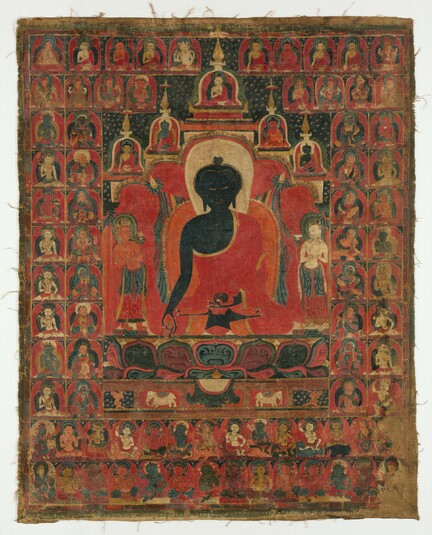
Item: Medicine Buddha
| Origin Location | Ladakh, Northern India |
|---|---|
| Date Range | 1400 - 1499 |
| Collection | U. of Michigan Museum of Anthropology |
| Catalogue # | #9596 Koelz Colletion |
Classification: Deity
Medicine Guru Buddha (Tibetan: sang gye men la. English: the Buddha - Guru of Medicine). (See the Medicine Buddha Main Page and the Outline Page).
Tibetan: Sang gye men la
The painting was most likely created in the Tsang Province of Central Tibet (U-tsang). The painting style does not conform to Western Tibetan painting styles of the time, nor does it have strong Kashmiri or Guge Kingdom influence in the drawing, colour palette or design motifs. The painting is most closely associated with other early works dated to the mid 15th century.
The painting was collected by Walter Koelz in Ladakh, North India, in the early 20th century.
At the top left (viewer's left) of the painting is what appears to be a Tibetan teacher. At the top right the figure is a Tibetan king. The register below has six Tibetan kings along with an Indian monk figure wearing a yellow hat and a bodhisattva - possibly Manjushri or Maitreya. Manjushri would be the more likely of the two.
The eight Buddhas including Shakyamuni as one of the eight along with Prajnaparamita is standard for depictions of Medicine Buddha and his fifty-one deity entourage contained in the mandala. The Tibetan kings are completely normal in painted depictions because they constitute members of the early Tibetan lineage for the initiation and practice of Medicine Buddha.
The Five Symbolic Buddhas are added by the artist as a standard convention however play no role in the mandala or practice of Medicine Buddha.
Suryabhaskara and Chandrabhaskara are typically depicted flanking the central Medicine Buddha.
The two inner vertical registers containing the Sixteen Great Elders (sthavira) are added by the artist or at the request of the donor. They play no role in the description or practice of Medicine Buddha.
The two outer vertical registers contain the Sixteen Bodhisattva which belong to the mandala proper. The two horizontal bottom registers contain the Ten Worldly Gods and Twelve Yaksha Generals. In the upper register, of the two lower, on the viewer's right side is a small figure of Dharmatala, standing, wearing heavy clothing and accompanied by a tiger. He is the attendant to the Sixteen Elders. In early paintings such as this it was not yet the convention to add the figure of Hvashang, the envoy of the Chinese emperor, who was considered the patron of the Elders.
Again on the outer right side, above the two horizontal registers, is the deity White Achala. He also is unrelated to Medicine Buddha.
The bottom right and left corners, and the two figures directly above, most probably depict the Four Guardian/Direction Kings - not donor figures or teachers.
The composition has too many bodhisattva-like figures. There are eighteen in total which include Suryabhaskara and Chandrabhaskara. This can be accounted for either by identifying the subject of the painting as the fifty-three or fifty-five deity Medicine Buddha and mandala figures. It is also possible that some of the extra bodhisattva-like figures, such as the Manjushri in the second register at the top, or some of the figures in the two vertical registers are deities.
Jeff Watt 1-2015
Collection of Harvard Art Museums Main Page
Region: Ladakh, Northern India
Buddhist Deity: Medicine Buddha Main Page
Collection of University of Michigan (Koelz Collection)
Buddhist Deity: Medicine Buddha (All 51 Figures)
Painting Style: Guge Kingdom (Western Tibet)
Buddhist Deity: Medicine Buddha (Early Paintings)
Collection of Harvard Art Museums (Masterworks)


